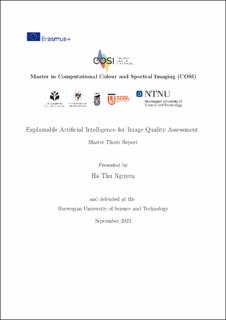| dc.description.abstract | Image quality assessment has been an active research field for decades because
of the high demand for images and video content in daily life. As visual information
is processed in various steps from acquisition and storage to transmission, they
are often degraded by multiple types of distortions. It is necessary to evaluate the
quality of any imaging system to maintain the user’s experience. Thus, objective
image quality assessments were proposed to objectively evaluate the image quality
as close to the perceptual quality rated by human users.
Among the three types of image quality assessment, No-Reference image quality
assessment (NR-IQA) has the most potential to be used in various applications and
is also the most challenging topic. The traditional NR-IQA metrics were proposed
using domain knowledge of natural images to extract hand-crafted features that
can indicate the degradation degree of the distorted image. Recently, many deep
learning models have been used in NR-IQA and outperform the traditional method
in predicting image quality. However, they are still data-driven models which
contain numerous parameters and lack explainability. Therefore, it is challenging
to understand how such deep NR-IQA models estimate the quality of images and
why they do not work on some images. Moreover, although many different methods
of explaining a deep learning model have been introduced, there is no work that
targets to image quality assessment.
In this work, we address the research gap in the explanation for the deep NRIQA model. Firstly, we defined a set of definitions and expectations for explainable
artificial intelligence (XAI) in the field of image quality assessment. Then, we
proposed a framework to provide explanations at different levels: from global to
local prediction for the model. The global explanations were formed by analyzing
the images that the model can not predict their quality accurately. To find such
an image, we proposed to use objective detection methods for IQA models. We
also used different existing XAI methods to obtain explanations for the model in
different information domains from spatial, and frequency to color space.
Different explanation results are discussed in our project. We found out that the
existing XAI methods can explain NR-IQA models to some extent. However, there is
no current way to evaluate the effectiveness of those explanations for image quality
assessment problems. Future work is needed to provide an objective evaluation
of XAI for image quality assessment or to find an alternative method to better
explain NR-IQA models. | |
